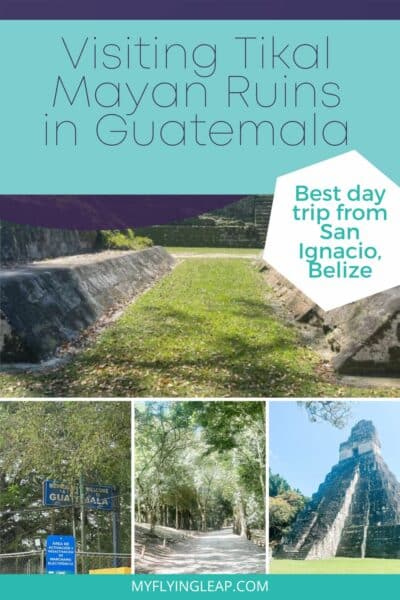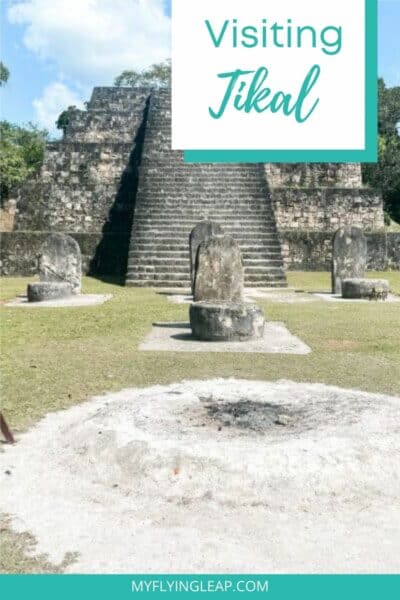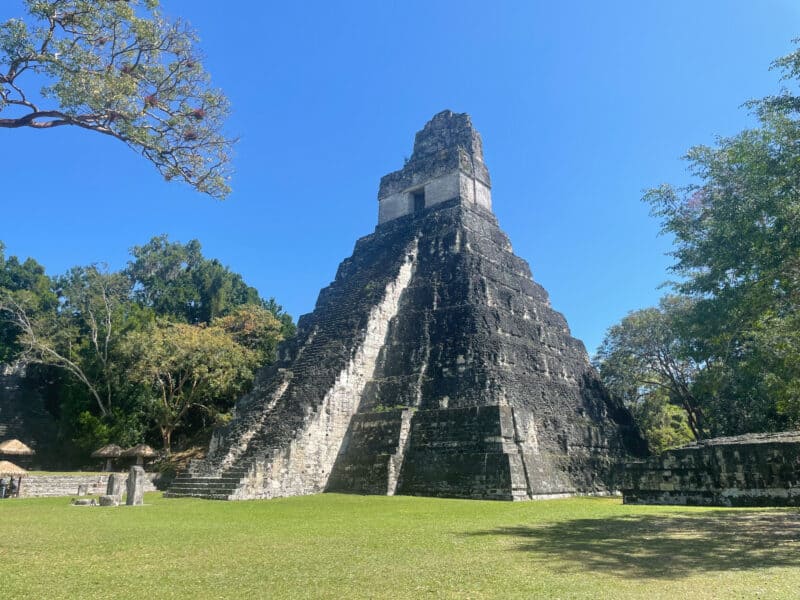Visit Tikal—Day Trip to Tikal from San Ignacio, Belize
Planning to visit Tikal, the incredible Mayan ruins in northern Guatemala?
Seeing Mayan ruins is one of the most popular things to do in Belize and Guatemala. There are many different ruins, and San Ignacio, Belize, is a great location to visit from.
A day trip to Tikal from San Ignacio, Belize, is one of the top things to do. And given San Ignacio is only a few miles from the Guatemala border, it’s easy!
Looking to decide if you should visit Tikal, and what is the best way of planning your day trip to Tikal from San Ignacio, Belize? Read on to find out more about Tikal, why you should go, and the best way to make the trip.
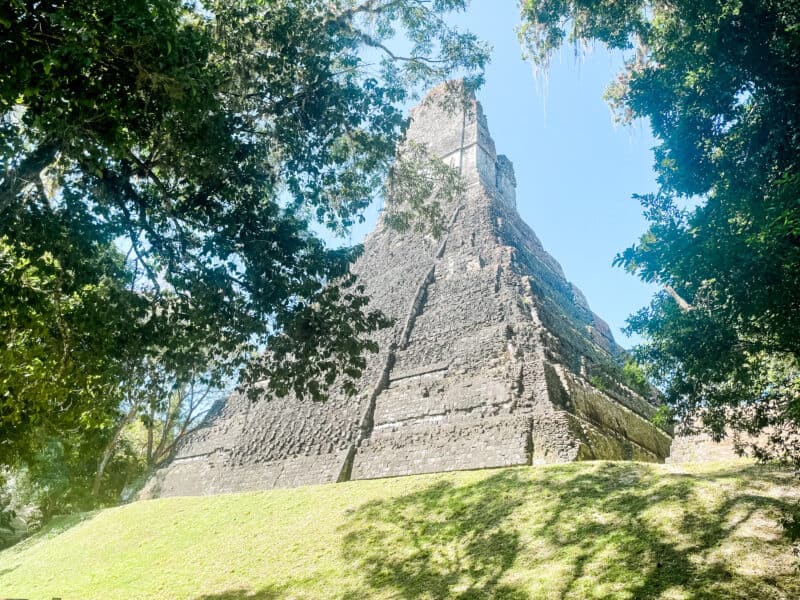
Some links in this article may be affiliate links, which means that if you purchase through them, I receive a small commission. This will never cost you extra. Please read the disclosures to learn more.
History of Tikal & Why It’s Important
Tikal is the ruin of an ancient Mayan city located in the rainforest in northern Guatemala. It was believed to have over 3,000 structures and 100,000 people living there at its peak.
Development of the area may have started as early as the 4th century B.C., though evidence has been found of a settlement from around the 8th century B.C. The peak of this capital city dates to the Classic Period between 200 and 900 A.D.
It was a major Pre-Colombian city known for its political, military, and economic stronghold in the area. Tikal represents the Mayan people’s sophistication, intelligence, and technical and artistic strengths.
Locals knew of this ancient ruin. However, it wasn’t excavated and fully surveyed until the mid-19th century, led by the University of Pennsylvania. It’s now one of the best-understood sites in Central America.
It’s believed this city fell slowly due primarily to the impact of long periods of drought. The lack of water caused a reduction in cultivated food production and the spread of disease.
This led to people losing faith in the local leaders, causing them to expand outwards. As people migrated from the city, the jungle reclaimed the area for over a thousand years.
Why Tikal is Important
Tikal, and Tikal National Park, was declared a UNESCO World Heritage Site in 1979. It represents one of the largest Mayan urban centers and archaeological sites.
It’s one of the few UNESCO sites inscribed to the list for cultural and natural criteria. The incredible biodiversity of the area, comprised of wetlands, savannah, palm forests, and more, makes it an incredible area for wildlife, birds, and plant life.
There’s also incredible diversity in the architectural aspects of this ancient city. From the construction of the many buildings used for administrative, residential, and ceremonial functions to the sculptural aspects, Tikal is a masterpiece you shouldn’t miss.
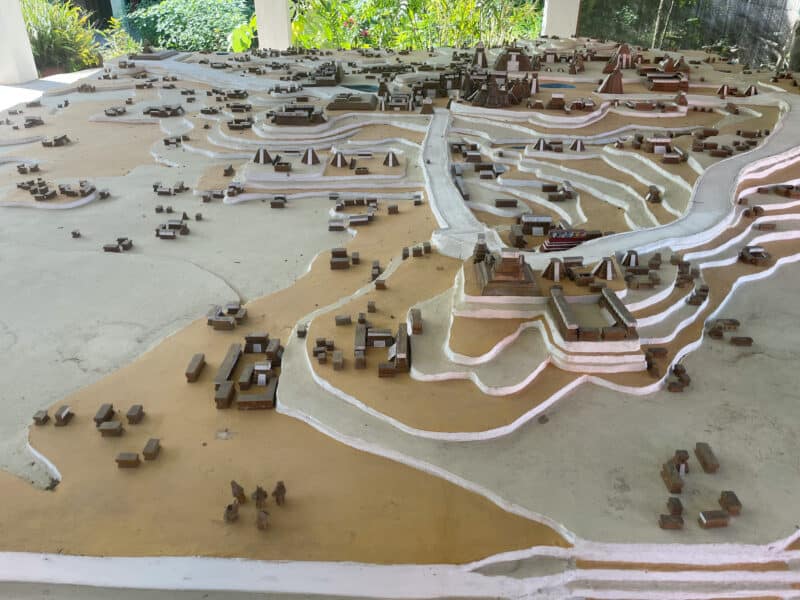
About Tikal and What to See at Tikal
Tikal National Park is just over 350 square miles (575 kilometers), including jungle and an inner urban zone of around 10 square miles (16 km). Within this area, the majority of the monumental architecture was found on approximately 3 acres of land.
The ancient city center includes palaces, temples and pyramids, residences, ball courts, squares, roads, and more. Some of the larger squares are well excavated, though there is still evidence of work being done.
Other structures show as large earthen mounds from the jungle taking them over. It’s easy to see the largest of these hide massive structures below. It’s so incredible to think about the jungle taking over this massive ancient city.
If you’re lucky, you’ll see wildlife. We saw some beautifully-colored wild turkeys and a coati, and we heard some howler monkeys.


You’ll also see the Ceiba tree near the entrance of the park. This is the national tree of Guatemala, and it holds a special place for the Mayan people. The top of the tree represents the afterworld, the trunk represents the living world, and the roots the underworld.

Areas to Visit in Tikal
The inner urban zone of Tikal is around ten square miles, so that’s certainly more than you can cover in a day or two. You’ll want to prioritize your time based on what you’re most interested in seeing.
This is why it’s a great idea to have a guide—not only to learn the history and get perspective of what you are seeing but to help you strategically plan your visit based on your available time.
Based on our visit and our guide’s recommendations, here are some top areas to visit in Tikal National Park.

Grand Plaza
Your first stop in the mega-complex of Tikal should be the Grand Plaza. It holds some of the most incredible temples in this area, and it’s worth spending time there.
Two large temples flock the ends of the plaza. Temple I, the Temple of the Grand Jaguar, is on one end. On the other is Temple II, the Temple of the Masks.
Tikal is known as the “City of Voices” or the “City of Echoes.” The ruler could stand at the top of Temple I and be heard throughout the plaza.
Then, on the sides of the plaza, you’ll find terraces, palaces (including Palacio Maler), and ball courts. The Central Acropolis is here, the residential area for the royal family.
It’s interesting to walk through this area as some of the door frames made of wood are petrified and remain.
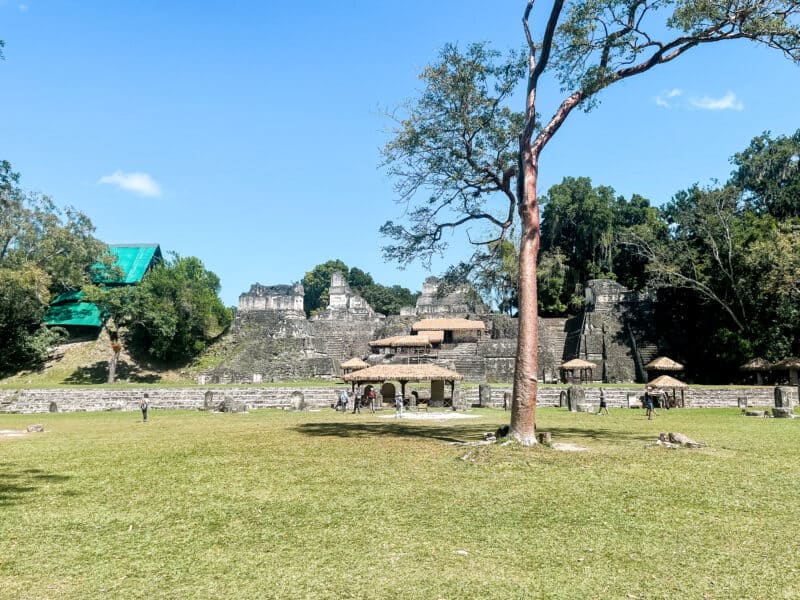
This was the heart of the city and the center of Mayan civilization in Tikal. You’ll see stellas (large carved stone slabs) in front of the burials and temples designed for protection.
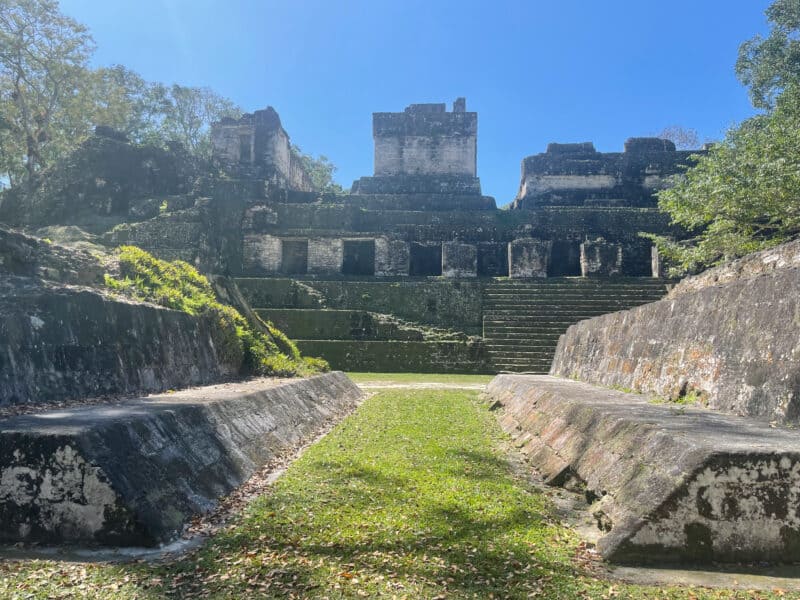
Temple I (Temple of the Grand Jaguar)
This plaza is a sight to see! Temple I is around 150 feet tall (45 meters), and it’s the representation of Tikal that you’ll see in photographs and images of the park.
A stone stairway guides your eyes up the pyramid’s nine tiers, which were built to pay homage to the nine levels of the Mayan underworld. There is one entrance in front.
This temple was built to honor the gods. It took approximately 20 years to build, and it’s believed slave labor may have been used. It was built around 745 A.D.
The tomb of one of Tikal’s greatest rulers was found inside this temple. The tomb of this ruler, Ah Cacau (Lord Chocolate), is located near the visitor center, with all of its adornments.
Research shows he was called Ah Cacau (Lord Chocolate), though my guide called him Jasaw Chaa-n Kawil. If you look up to the top of the temple, you can see the faint etching of a face.
Two altars in front of the temple were for him and his son. His son actually finished the construction of the temple. To the left of the temple, you’ll see an altar dedicated to his wife, who ruled for his son until he came of age.
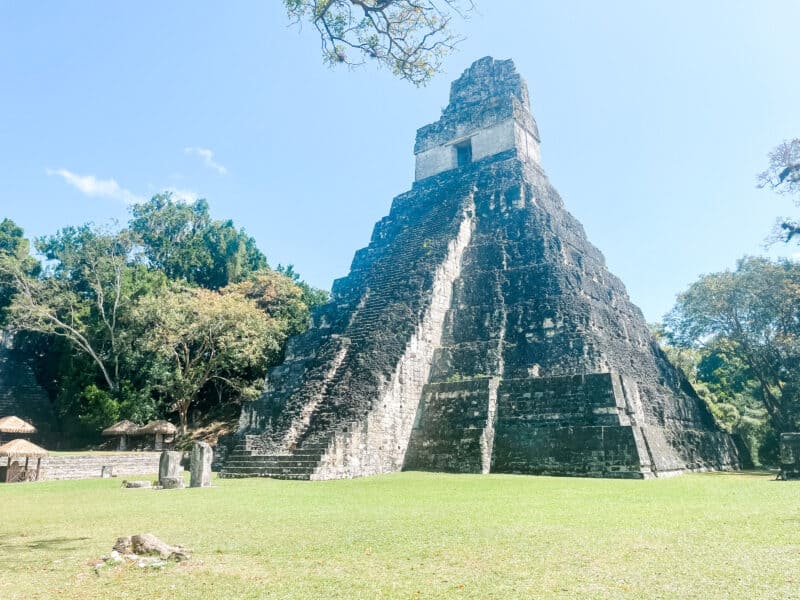
Temple II (Temple of the Masks)
Temple II lies at the opposite end of the Grand Plaza. It has three levels representing the upper world, the mortal world, and the underworld.
The sun rises directly over Temple I at the equinox, and the shadow touches Temple II at the bottom. At sunset, the opposite happens. This may have been done so the king and queen stay together for eternity.
Tourists are no longer allowed to climb the steps in Temple I, but you can climb a staircase wrapped around the back and side of Temple II. Don’t skip this, as you get the most incredible views of this area.
Temple I has yielded other treasures, including intricately carved wooden lintels over its doors, which have furnished clues to Maya beliefs and cosmology.
Temple of the Masks is called Temple because of huge stone masks guarding its stairway, Temple II is almost as tall as Temple I but safer to climb. Its summit offers travel-poster views of the Great Plaza and two labyrinthine ceremonial and residential complexes named the North Acropolis and the Central Acropolis.
Temples ! and II were also built to be aligned with Orion’s Belt.

Temple IV & Temple V
Temple IV is another worth climbing. It’s actually the tallest in Tikal at around 210 feet (70 meters). It’s not only the tallest in Tikal but also the tallest pre-Columbian structure anywhere.
At the top of the stairs that run up the side of this temple, there are around a dozen carved steps to get towards the top of the structure. They are tall steps, and though it looks like if you slip, you’ll fall into the abyss, there is actually a small train beneath them.
For the climb, you get more incredible views of the jungle and the tops of some of the temples and pyramids of Tikal. You’ll find lots of people hanging out up here, enjoying the views. I believe this is the temple climbed for sunset views.
Temple V is in a small clearing in the jungle, and it appears to reveal itself out of nowhere. It’s the second highest in the park and was constructed around 700 A.D.
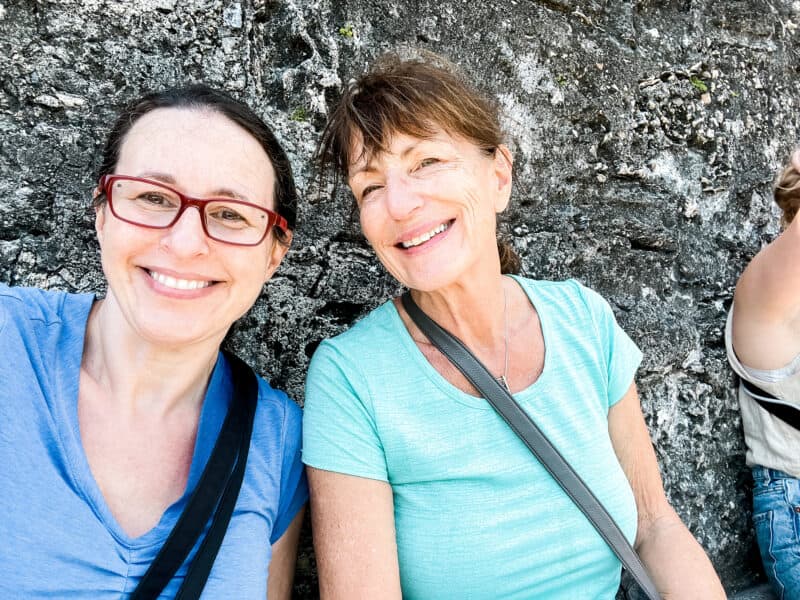

Lost World Pyramid, Grand Pyramid, & Grand Temple
On the way to the Lost World Pyramid, you may pass by Temple III. The trees were cleared from this temple in the 1950s, and you can see the jungle taking it back. It was the last built and the third largest temple.
The Lost World Pyramid was built around 250 B.C., and it’s one of the oldest structures in the area. The Grand Pyramid is also in this area, and the two structures are aligned as Temples I and II are.

At the solstice, the Grand Pyramid’s shadow falls into the temple’s windows in the area. It started small—not much larger than a person’s size, but 37 sub-structures were added around the pyramid and to the top.
Construction in this area on the pyramids continued until around 600 A.D. Construction of Temple 3 (Grand Temple) was around 820 A.D.
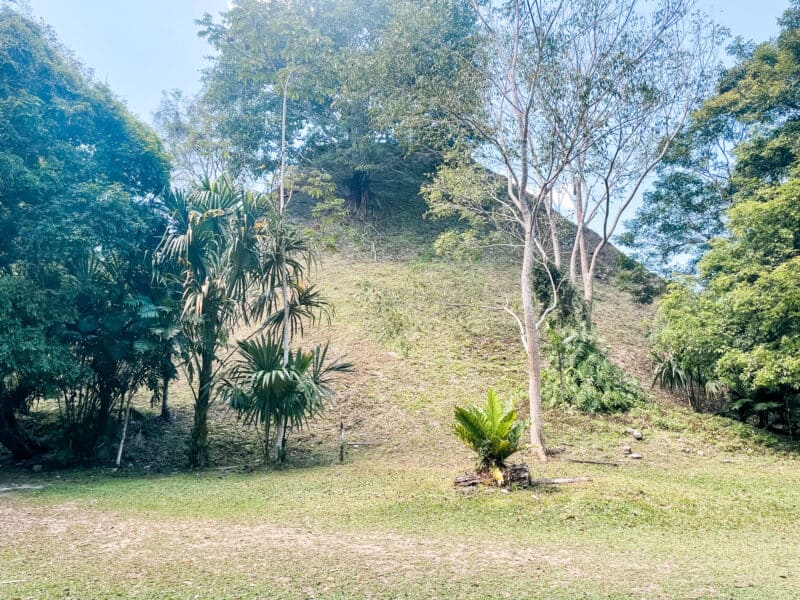
Climb to the top of the Grand Temple for 360-degree views of the area. It’s gorgeous and worth the climb of around 140 steps. I believe sunrise tours of Tikal start here.

The Complex of Twin Pyramids
In this area of Tikal, there are four buildings, two in the east and two in the west. They represent life and darkness.
There are also two other buildings, a palace, an oratory center—a worship area. In front of one of the pyramids is a modern altar used today by the Mayan people.
What’s interesting in this area is that if you stand in front of the pyramid with an altar and clap, it sounds like a bird’s call!

Visiting Tikal
Here are the essential details for visiting Tikal:
- Tikal entrance fee: 150 GTQ (around $20 USD) for adults, and children under 12 are free. Sunrise tours entering the park before 6 a.m. cost 240 GTQ (around $32 USD).
- Hours: 6 a.m. to 5 p.m. daily
- Tickets purchased after 3 p.m. are good for the following day as well.
- Tikal tickets are not available online at this time.
- Guides are not required but are recommended. It’s a good idea to book them in advance to ensure the guide speaks your language. Some are available at the entrance of the park if preferred.
- Tours often include the park entrance fee, though you should check to be sure. Tours purchased in advance often include the cost of transportation, but you should also check the details.
- ATMs are not available in the park, so get cash before you arrive. Credit cards are not accepted in the park.
- There are a couple of restaurants within the park that are reasonably priced and a couple just outside of the park. Bring cash!

What to Bring to Tikal
It’s a good idea to plan what you pack for visiting Tikal. Here are some suggestions, including typical day trip suggestions and some specific to this trip.
- Water—You can buy water in a few spots in the park, but it’s better to bring your own to limit your use of single-use plastics. I love this bottle with a filter that packs down to nearly nothing! And for an added bonus, it’s soft-sided, so you can filter water through it and squeeze it into a larger container if you want to bring more.
- Snacks—Bring snacks that will travel well and can handle hot temperatures. I love things like nuts and dried fruit for trips like this, or you can go with a granola bar or fruit if you’d prefer. You can get some things in the park, like fruit, snacks, and drinks, though there isn’t a wide selection.
- Sunscreen or SPF clothing—You can never have too much sunscreen if you’re as pale-skinned as I am! I love this sunscreen for my body and this sunscreen for my face. A hat is a good idea as well.
- Comfortable walking shoes or hiking shoes—You’re going to do a lot of walking in Tikal National Park, so make sure you take care of your feet. You’ll want to cover as much ground as you can during your visit! If you’re looking for hiking shoes, which aren’t a bad idea for Tikal, here are some great hiking shoes for women and men.
- Cash—You need to bring cash to Tikal National Park, as credit cards aren’t accepted. If you visit with a tour, the entrance fee will generally be paid for, so you may be able to do without. Some places accept money from Belize, but better to bring local currency if you can.
Other Items to Bring to Tikal
- Bug repellant—The bugs weren’t bad when I visited in late February, but it’s always a good idea to be prepared for mosquitos. I sprayed my clothing with Sawyer permethrin before leaving for my trip. I love this stuff, as it lasts for up to six washes. And I used Picaridin, which now comes in a travel-sized spray and a cream.
- Passport—If you’re visiting Tikal from San Ignacio, Belize, it’s a must to bring your passport. You will leave the country of Belize to enter Guatemala.
If you’re going on a sunrise or sunset tour, a headlamp or a small clip-on flashlight is a good idea. You can use your phone, but you’re best with something you can strap onto you when you’re climbing the temples.
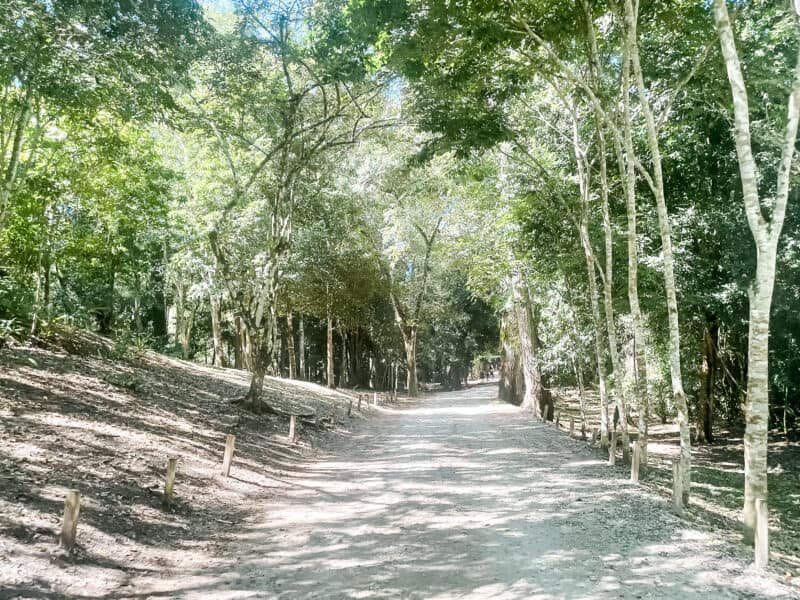
Best Time to Visit Tikal
When planning your visit to Tikal, you’ll factor in the weather and tourist season timing, given how popular this site is.
This area in Central America generally has two seasons: rainy and dry. The dry season runs from November to April and is the most popular time to visit.
Daily afternoon showers are expected in the rainy season and can last all afternoon or even for much of the day. And the humidity spikes as well in an already humid area, even in the dry season.
Though the dry season is for nearly half of the year, the best time to visit is in February and March. The high season is generally from December through March, with peak tourist times around the holidays of Christmas and Easter.
Avoiding these times means fewer crowds and lower prices. We visited in late February, and it was wonderful! There were many tourists, but we didn’t feel like the place was overrun. And it was hot and humid but nice in the shade.
How Long to Visit Tikal
The ride to Tikal is beautiful. And there was thick fog in the morning that burned off as the sun rose. We were told it’s best to go in the morning, as it’s hot all year round once the fog burns off.
You could easily spend days at Tikal and still not see everything. However, with a guide who knows the area well, you can strategically see the most important and impressive spots in a day. It’s a busy day, and you’ll constantly be moving, but it’s worth it!
If you have more time, use it. You have options to stay in the park or nearby so you can maximize your time. But if you only have one day, you can easily make the most of it by seeing the top spots in Tikal.
How to Get to Tikal
The easiest way to visit Tikal is on a guided tour, whether in Guatemala or Belize (though, especially in Belize!).
Visiting from Belize
If you’re visiting from Belize (San Ignacio is the closest town), you need to navigate crossing the border. You’ll also need to arrange transportation on each side so a tour can do this for you.
There are ways to do it on your own if you rent a car. Our guide told us that only one car rental place, Crystal Car Rentals, could accommodate this. They provide a package of the information you need to cross the border into Guatemala and back into Belize for around $75 USD.
With a tour, they do the coordination for you. We had a driver take us to the border, and another driver with a guide picked us up on the other side. We went through immigration and got our passports stamped.
You’ll pass through the border town of Benque Viejo del Carmen in Guatemala. Its claim to fame was that the local sapodilla trees provided the base for chewing gum and chicle. Wrigley purchased it from here, as did others. Now only Bazooka does.
Alternatively, you can go to Flores, the closest city to Tikal in Guatemala. You can also get guides from there if you don’t want to rent a car. Or you can take a bus from Flores to Tikal.
Looking for a tour from San Ignacio? Check out this great small-group tour option to Tikal. Or if you want a private tour to Tikal like I did, it’s only a little more. I thought it was worth it.

Visiting from Guatemala
If you’re flying into Guatemala, the closest airport is in Flores, Guatemala. It’s around 90 minutes by bus to get to Tikal. Here’s a great option if you’d rather do a day tour from Flores.
If you’d like a private sunrise tour from Flores, check out this tour! Or a group sunset tour—there are so many options!
Crossing the Border into Guatemala
There is a large yellow building with lanes to the right that you pass through to get to Guatemala. The lanes are for cars, buses, and vans, though many tour companies have people walk through and get picked up on the other end.
In the building is an immigration booth. You pay an exit fee from Belize of $20 USD/$40 BZE. They check your passport and stamp it to send you through.
You then walk through what’s considered “no man’s land.” It’s an area between the two countries. The Mopan River splits Belize and Guatemala, but the border between the countries isn’t officially defined.

We entered the immigration building/welcome center in Guatemala, and our guide met us there. The currency in Belize is called Quetzal, and many places do not accept US dollars. It’s a good idea to pick up some of the local currency (at a bank or get it changed).
From there, it’s a one-hour and 40-minute drive to Tikal.

How to Get Around Tikal
Tikal is quite easy to navigate by foot. There are walking paths linking the various sites and complexes, and they are flat and easy to navigate.
You can purchase a map if you don’t go with a guide or take a photo of the site map near the entrance.
If you want to save some time and footsteps, a truck makes a few stops running from just after the entrance to the park. There isn’t a cost, but provide a small tip to the driver.
Where to Stay at Tikal
If you want to stay at Tikal for the night, you have some great options right inside Tikal National Park.
Jungle Lodge Hotel—This is a great option for a wide budget range as they offer a hotel and a hotel onsite. The hotel is a bit spendy (relative to local hotels), and the hostel is quite affordable. It’s located near one of the two entrances (but not the one that sells tickets).
Jaguar Inn—This is a great spot if you’re looking for a hotel right next to the ruins on a budget. You can camp in tents or rent a hotel room.
Tikal National Park Campground—This is a good spot if you’re on a camping trip and looking for a place to stay. Get there early to reserve a spot.
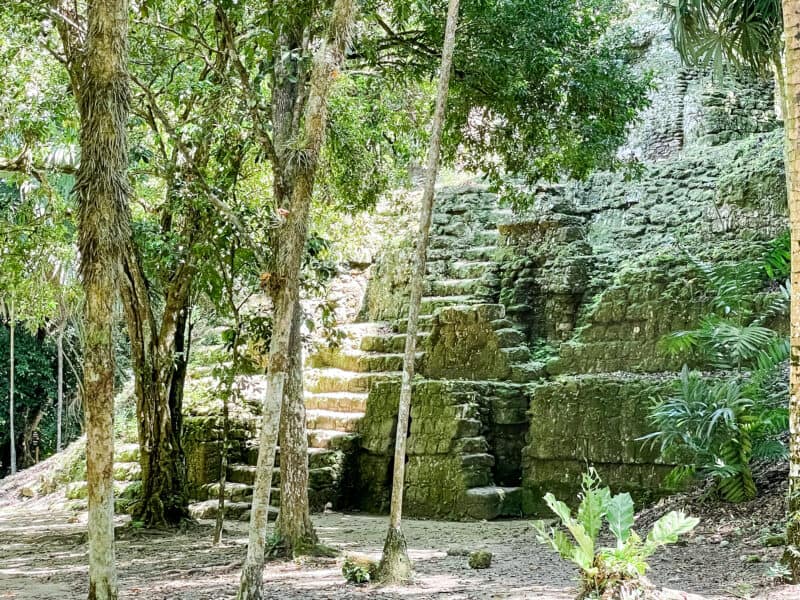
Tips to Visit Tikal
If you’re going on a Tikal day tour or longer, here are some recommendations for the best tips to visit Tikal National Park.
- Get a guide—Though you’re not required to use a guide in Tikal National Park, it’s a good idea and one I highly recommend. Guides study for a year and test to certify. They take tests annually to keep the certification updated. There is a lot to see in Tikal, and having someone show you the highlights and explain what you are looking at and the history is helpful. If you wait to hire a guide at the park, you may find they don’t speak English. So, it’s best to go with one to ensure you will be able to understand (unless you’re fluent in Spanish, of course!)
- Bring water—You can purchase water at a few spots in the park, but it’s better to bring your own to reduce your use of single-use plastics.
- Arrival time—Plan to get to the park as early as possible to maximize your time. It’s also good to get there early to get some of your steps in before the heat of the day.
- Don’t forget your passport—If you’re visiting from Belize, you must bring your passport to get into Guatemala and return to Belize. Don’t forget it!
- Climb the temples where you can—Many of the temples allow climbing and even have staircases to make it easier. You get incredible views on top of these places, so don’t skip this!
- Bring cash—There are no ATMs in the park, and credit cards aren’t accepted. Stop to get cash before entering, and make sure you have the local Guatemalan currency. Belizean currency may be accepted, but it’s not a sure thing.
- Wear comfortable and supportive shoes—You’ll be doing a lot of walking and a good bit of climbing. Don’t wear sandals or shoes without traction.

Visit Tikal—Is It Worth It?
You might ask yourself if a day trip to Tikal is worth it, and I’d say a resounding YES! It’s an incredible place to visit, particularly if you’re interested in history and culture. The Mayan People are fascinating!
And since Tikal is a UNESCO World Heritage site, you know it’s going to be an incredible place to visit and well worth your time. It was the first site of mixed heritage—cultural and natural, to be listed as a UNESCO site.
Whether it’s just a Tikal day trip or more there, make the most of your time at Tikal. It’s an incredible and unique spot and definitely a bucket list or once-in-a-lifetime place to visit.
You Might Also Like
- Chocolate Tour Belize—AJAW Chocolate, San Ignacio
- 8 Top Things to Do in San Ignacio, Belize
- ATM Cave Tour—Most Sacred Cave in Belize
- Belize Barrier Reef Snorkeling from San Pedro, Ambergris Caye
- 5 Day Trips from San Ignacio, Belize
- Xunantunich Mayan Ruins—Top Ancient Mayan Ruins in Belize
- Mayan Healing Medicine—Mayan Medicinal Plant Walking Tour
- 7 Incredible Things to Do in Ambergris Caye
Like it? Pin it!

